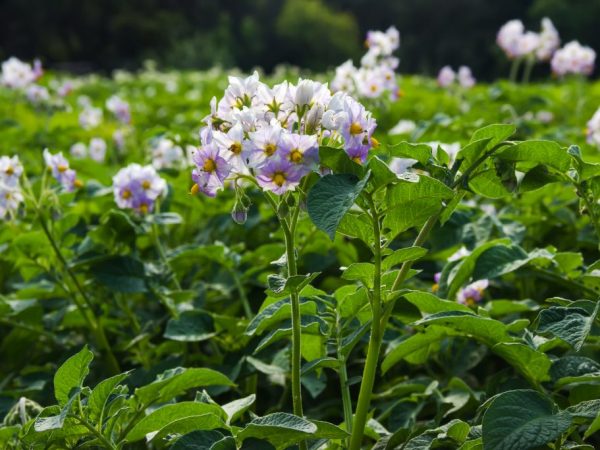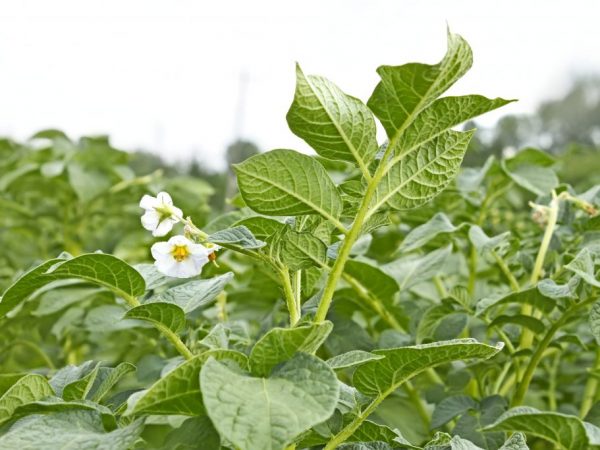How to feed potatoes during the flowering period
Potatoes - can be called the most frequent guest of the dinner table. Many different dishes have potatoes in their composition. Therefore, it will not be surprising that this particular vegetable crop is actively grown in our country. But in order to get a rich harvest, it is not enough just to take care of the bushes, it is also necessary to apply fertilizers correctly, and most importantly, at the exact time. Each stage of plant growth involves the introduction of certain funds. Initially, these are organic additives. Potassium sulfate is added before the buds begin to appear. Top dressing of potatoes during flowering is fertilization with superphosphate.

Top dressing of potatoes during flowering
Types of dressings
Potatoes are a complex organic system that has a unique breeding program.
It is generally accepted that this crop absorbs feeding poorly, so many believe that fertilization is necessary in the spring. By the beginning of flowering, the bush assimilates only ½ of the added food, respectively, after germination and before budding, it will eat what is left. To prevent this from happening, the plant must be fertilized with certain substances, for each of which there is a specific time. Top dressing of potatoes is of 2 types:
- Root.
- Foliar.
Features of root feeding
The root is produced using agricultural machinery (cultivators: hillers, plant feeders) for these purposes, MAM (herbicide - ammonia machines) are also used. This type of addition will give a result if it is done on time, plus it is suitable for waterlogged and sandy soil.
Root feeding has several options:
- superficial;
- intrasoil;
- "Under the count".
From the name superficial it is already clear that it is carried out exclusively on the ground. With such a procedure, the application time must be observed, it is best if it is in the evening, since in the afternoon, due to moisture, burns can appear on the leaves.
Top dressing of potatoes immediately after germination is carried out by an intra-soil method, since it involves the introduction of fertilizer into the root-accessible layer of the earth. Which will not cause any risks for the bush itself.
To feed the potatoes "under the stake", before starting it is necessary to hammer a small stake between the bushes, after which it is pulled out, and depressions are obtained in the soil. Fertilizers are poured into it. This is one of the safest ways, since the plant will receive everything it needs for development, and the root system will be safe and sound.
Features of foliar feeding
Foliar, also divided into certain subspecies:
Manganese
This type of feeding is important in that manganese prevents the appearance of voids in root crops, in addition, enhances the taste characteristics.
Nitrogen
For these purposes, urea can be used (most often the term urea is used).The concentration of the introduced substances is calculated based on the characteristics of the soil, if it is not diluted correctly, then in the end the potato can get burned. Another option for nitrogen feeding: 2 g of potassium chloride and ammonium nitrate are taken, 20 g of superphosphate and only 0.10 g of vitriol are added here. All ingredients are poured with warm water, mixed and left for 2.5-3.5 hours. Next, the solution is filtered and placed in the required container. It is especially useful to apply after bud emergence, at the beginning of the flowering period. Indeed, thanks to this, the necessary chemical, biological and physiological processes are triggered, and the plant's resistance to diseases increases.
Phosphorus

Mandatory feeding
Ideal for medium to late varieties. Thanks to superphosphate, not only the yield indicator and the amount of starch in the fruits increase.
Also, before starting work, you need to know about all the factors that affect the process of assimilation of nutrients by potatoes:
- soil acidity level;
- planting frequency;
- climatic features;
- the condition of the bushes.
Fertilizing flowering potatoes
Experienced growers know that the process of adding additional minerals requires adherence to a time frame.
The first stage is performed after the appearance of the pagons. To understand that the plant needs additional preparations, it is necessary to carefully examine it and if it is found: poor development of pagon and pale green leaves, then this serves as a signal to prepare supplements, consisting mainly of organic elements. For this, mullein, bird (even chicken) droppings, urea and water are taken. The proportion looks like this: 0.5l: 1 tbsp: 1 tbsp: 10l. On average, one bush takes 500 ml of solution, so to calculate how much of all this fertilizer is needed, it is enough to multiply the number of plants by 500.
Before budding begins, inorganic and organic additives are added. One of them consists of the following components: 1 large glass of ash (preferably wood), a spoonful of potassium sulfate is added to it and all this is diluted with a bucket of water. From such complementary foods, potatoes will develop faster, respectively, this will bring the beginning of flowering closer.
The final stage of feeding falls on the period before or during flowering, when roots begin to form, so the potatoes need enhanced nutrition. On the 5-6th day after the beginning of the mass appearance of flowers, to accelerate the development of tubers, take superphosphate, mushy chicken droppings or mullein, dilute all this in water and pour about 500 ml under the bush. The proportion of the components: 2 tablespoons: 1 tablespoon: 10 liters.
If the area of the cultivated area is more than 90-100 m2, then it will be more profitable to use soil fertilization with dry substances. You can use the same superphosphate, manganese, potassium sulfate, etc.
As a preventive measure, experts recommend Gumat. Because of its properties, it is called a plant anti-stress drug. After all, it helps to survive, develop, despite external stimuli and difficult conditions.
Caveats
The addition of organic and inorganic additives to potatoes can also have a negative side.
If too much mullein or bird droppings are introduced into the soil, then it is quite possible that pests (bears) will appear in the soil.
Excessive application of nitrogen fertilizers causes the plant to lay down, instead of buds forming on it. In such a situation, the vegetable grower will have to remove the top of the tops (approximately 1⁄4 of the length of the stem), then add wood ash to the soil, 1 large glass for 1 linear meter of the garden bed. In order to prevent this, before starting the procedure, the vegetable grower needs to clearly study the proportions and method of adding additives.
Conclusion
Any plant needs timely care, proper hilling, watering and natural fertilization.Only if you follow these simple points in the end you can get a good, beautiful and most importantly delicious harvest.


